The Bedfordshire Regiment in the Great War

Officers who died serving in the 8th Battalion
(This roll of honour is in chronological order)
|
Killed in action 17th December 1915, aged 30. Before war broke out, Rupert was a brewer, presumably connected to his family's brewery. The red haired, blue eyed brewer joined the 7th Royal Fusiliers (the 'Empire battalion') as Private 625 on 9th September 1914. He was unknowingly in the same queue as Sidney Vipond, who would also become an officer in the 8th battalion and be killed in action. Rupert was 29 years and 10 months old and was a resident of Cowes on the Isle of Wight at the time. He had previously been an officer in the Militia of the Somerset Light Infantry so was soon to be commissioned as an officer in the Bedfordshire regiment on 24th November 1914. Although he joined the regiment at the outbreak of war, he had only been in France for three weeks when, on the 17th December, the battalions trenches were heavily shelled and Rupert was caught by the shelling. His death appeared on page 4 of the 23rd December issue of the Times and page 13 on 27th December 1915. Rupert was the son of Colonel John Gretton, C.B.E., M.P., and Mary Louisa Gretton of Stapleton Park in Melton Mowbray and the younger brother of Colonel John Gretton M.P. (who was also the chairman of Bass, Ratcliff and Gretton). He has no known grave but is remembered on the Ypres (Menin Gate) Memorial. His officer's service number was 19218 and what remains of his record is held at the National Archives. |
|
Died of Wounds 21st December 1915.
He initially served as Private 32981 in the R.A.M.C. but applied for a commission in the Reserve of Officers 22 January 1915; at the time he lived with his mother at Norfolk House, 63 Lee Road, Blackheath. On 5 February 1915 Charles was discharged from the R.A.M.C. and gazetted a Second Lieutenant in the 3rd Battalion, Bedfordshire Regiment. After Officer training he was sent to France on 4 October 1915, was posted to the 8th battalion and arrived with them on the front lines 18 October 1915. During the intense bombardment of 20 December 1915 Lieutenant Shippey was caught in the abdomen by a shell fragment and rushed to No.10 Casualty Clearing Station, but died from his wounds early the following morning. He is buried Lijssenthoek military cemetery, on the site of the casualty Clearing Station where he died. A photograph of his gravestone can be seen here. His brother James Reginald SHIPPEY was an 'Old Contemptible' who went to France in the 1st battalion as part of the First British Expeditionary Force in August. He also fell in the regiment and his biography can be found here. |
|
Died of wounds 17th February 1916, aged 23. He arrived in France as a Lieutenant with the battalion in August 1915 and on 24th September was promoted to Temporary Captain. Having taken part in the Battle of Loos and surviving the December engagement, whilst on leave in February 1916, he contracted Acute tonsillitis. By the 8th February 1916 had fully recovered and reported for duty 2 days later. Within days of his return, Edward was to lose his life. At 2am on the 15th February 1916 he and Lieutenant Mitchell (above) were out on patrol when they were both caught by a burst of machine gun fire. Lt Mitchell was killed outright but Captain Simeons was wounded in the head, left thigh and received a fractured right arm. He was recovered and rushed back to the medical facilities but died two days later at No.10 Casualty Clearing Station (CCS) in Lijssentheok, 1km south of Poperinghe, where he is buried. He was the second son of Charles and Edith Simeons, of Dudley, Blyth Road in Bromley, Kent and his death was recorded on page 6 of the 21st February 1916 edition of the Times. Edward's officer's service number was 31293 and his record is held at the National Archives under reference WO339/14851. |
On the 19th April 1916 Germans artillery bombarded the battalions trenches constantly all day, causing many casualties. A particularly effective German raid on the heels of the barrage that night saw the battalion lose a section of trench and suffer the level of casualties only usually seen in a full scale assault, in what turned into a protracted brawl under cover of darkness. The "minor battle" saw the battalion lose almost 250 men with almost half of those being killed, which was a notably high percentage even in terms of the Great War. The following four Officers all lost their lives in the bloody fighting that developed that night.
|
Killed in action 19th April 1916, aged 27. Whilst in education at Dulwich College he served in the Cadet Rifle Corps and became an accountant one his studies were complete. When war was declared, the single, 25 year old accountant enlisted into the army on the 5th August 1914, into the Inns of Court Officer Training Corps as Private 955. He was 6 feet tall and weighed 137 pounds but by the 19th September was discharged to Commission in the 8th battalion of the Bedfordshire regiment. In May 1915 he was promoted to Temporary Captain and trained with them until they were posted to France on the 30th August 1915. Captain Quilter was mentioned in dispatches 30th April 1916, for his gallantry on the day he fell. Like Charles Cartwright (above) Roy was initially buried north of La Brique, 1 ½ miles north of Ypres, but his grave was later lost. Now he has no known grave but is remembered on the Ypres (Menin Gate) Memorial, which can be seen above. Roy's father had died by the time he was killed and his mother lived at 37 Kirkstall Hill. Streatham Hill in 1916. By the end of the war she had moved to 2 Ashurst Gardens in Tulse Hill, London. His service record is held at the National Archives within reference WO339/20183, with his officer's service number being 38947. |
On the 13th and 15th September the battalion were involved in a large assault during the Somme offensives of 1916 against a heavily fortified positions called the Quadrilateral, north-east of Guillemont. By the time they came out of the attack over 400 casualties had been sustained including 13 of the 16 Officers involved. Six Officers lost their lives during the fighting, being the next six in the list.
|
Second Lieutenant Frank Lloyd SHARPIN Died of wounds 14th October 1916, aged 33. Frank was educated at Bedford Grammar School and was working at the St. James' branch of the County and Westminster Bank when war broke out. He enlisted into D Company of the 1st battalion, Honourable Artillery Company (HAC) on 14th August 1914, becoming Private 1486 on the 25th. After just basic training, Frank went abroad with the battalion, who were one of the first Territorial Army units to be sent into a Theatre of War, arriving in France 28th December 1914. On 26th March 1915 he was wounded by shrapnel in the jaw and sent to No.8 Casualty Clearing Station and onto the 2nd General Hospital in Bailleul the next day. Frank returned to England on the H.M. Asturias, landing 30th March 1915. After recovering in the 3rd battalion of the HAC, on 25th September 1915 he was commissioned into the 9th battalion of the Bedfordshire Regiment and proceeded to Ampthill Park for training. Within his record is a curious event, considering his father's position and 'rank'. Whilst he was training to become an officer, a night out in Leicester Square, London on 24th April landed him in trouble with the Military Police and, when taken into their custody, also gave a false name (Stuart Riddle!). On 23rd May he was court martialled for 'Drunkenness' and Conduct to the prejudice of good order and military discipline' but was just severely reprimanded for his conduct. His address at the time was given as 45 St. Peter's Green in Bedford. After training was completed, he was attached to the 8th battalion and arrived with them in the field on 2nd October 1916. Second Lieutenant Sharpin received a gun-shot wound to the abdomen on the 12 October whilst in the front line east of Gueudecourt and died two days later from his wounds at No.34 Casualty Clearing Station. Frank is buried in Grove Town Cemetery, Meaulte, just south of Albert. By the time of his death, his father was the Venerable Archdeacon Sharpin and lived at 37 Eversley Road, Bexhill on Sea. His record is held at the National Archives under reference WO339/15085, with his officer's number being 31616. |
|
Second Lieutenant Walter Thomas SMITH Killed in action 3rd March 1917, aged 35. Both of the 'standard' sources record Walter as being killed in the 8th battalion but, although he served in the 8th battalion, further research suggests he fell in the 1st battalion instead. The information has been passed onto the appropriate authorities who will correct their records in time. As a result, his fascinating and full biography can be seen here. |
|
Second Lieutenant John Oswald TAYLOR Killed in action 19th April 1917, aged 28. John was gazetted as a 2/Lt in the 5th battalion of the Bedfordshire regiment on 19th December 1916 and was attached to the 8th battalion, arriving at the front with them in February 1917. Around two months later he was killed during a five day battle south of Loos when over 300 of the battalion became casualties. John Taylor was the son of James O. and Mary Elizabeth Taylor of Rotherwas Park in Hereford. He has no grave but is remembered on the Arras memorial to the missing. To date, I have beenunable to trace a service record at the National Archives. |
|
Captain James Elliot BLACK, M.C., M.B. Killed in action 19th April 1917, aged 30. During the assault against the Quadrilateral redoubt in September 1916, he tended the wounded under heavy machine gun and artillery fire, later venturing into no man's land to find more of the battalions wounded. For his actions he won a Military Cross and appears to have survived unscathed. On 23rd March 1917 he was admitted to a convalescent hospital sick but was back with the battalion in time for their assault around Loos in April 1917, where he was killed. The inventory of effects sent to his mother list just his pocket book, letters, wrist watch, cigarette case, a flask and a solitary medal ribbon, presumably being the Military Cross ribbon he earned only months earlier. He was the unmarried son of Adam Elliot Black and Mary Bruce Murray Black of Finglen in Campsie Glen, Stirlingshire and is buried in the Philosophe British Cemetery in Mazingarbe. At the time of his death, his widowed mother was the next of kin and lived at 18 Westbourne Terrace in Glasgow and appears to have moved to Finglen cottage, Campsie Glen in Stirlingshire before early 1918. James' long service number was 22632 and his record is held at the National Archives, under reference WO339/10835. (Image courtesy of the Imperial War Museum, reference HU 113901) |
|
Second Lieutenant Donald Samuel WRIGHT Died of wounds 25th April 1917, aged 22. Donald was commissioned as an officer into the 1st battalion and was later attached to the 8th battalion when he went to the Western front. He was leading his platoon forward when wounded by a shell in the lung and right eye on the 19th April during the fighting south of Loos. Donald was the only son of Samuel E. and Emma Westrope Wright, who lived in Lyndhurst, Walkern and owned the Victoria Brewery in Walkern, near Stevenage in Hertfordshire at the time of his death. He is buried in the Calais Southern cemetery, France. To date, I have beenunable to trace a service record at the National Archives. |
|
Died of wounds 18th June 1917, aged 25.
Frank was commissioned in November 1914 and was posted to the 8th battalion early in 1915. He arrived in France with them 30th August 1915 and fought in the battle of Loos within a few weeks of their arrival. Frank also survived the December action and on the 17th February 1916 he was promoted to Temporary Lieutenant, leaving the battalion for a welcomed spell of ordinary leave in England on the 26th March 1916. Whilst on leave he developed Influenza, which quickly turned into a 'touch of Pneumonia'. The 22nd April 1916 saw him struck off the battalion's strength and he lost a 'considerable amount of weight'. Having recovered from Influenza and Pneumonia Frank was passed as fit again late in July 1916 whilst serving in the 10th battalion at Dovercourt. On the 28th August 1916 he returned to France and rejoined the battalion on the 1st September. He immediately became acting captain in command of a Company and also survived the assault on the Quadrilateral Redoubt in September. On the 3rd December 1916 he led a small Officer patrol into German trenches, surprised and killed a sentry and returned to his lines with the information he was sent to acquire. Captain Body was admitted to the 16th Field Ambulance suffering from Epididymitis (inflammation of the Urinary system) on the 27th February 1917 and was sent to the 1st Casualty Clearing Station the same day. On the 1st March he was moved to the 1st Red Cross Hospital at Le Touquet, being recorded as 'slightly sick' and on the 19th March was again moved to the 39th General Hospital. After over two months Frank was discharged to the Base Depot in Calais on 11th May 1917 and rejoined B Company of the battalion on the 19th. On the 15th June 1917 he and another man were wounded whilst on a night time working party, during which Captain Body was shot in the head and spine. He was moved to the 18th Field Ambulance that day and onto the 33rd Casualty Clearing Station the next day but died from his wounds three days later at Bethune, aged 25. At the time of his death, his parents lived at "The Cedars," 34 Sydenham Hill in Sydenham, London. His record is held at the National Archives within reference WO339/1684, the officer's number being 2526. |
|
Lieutenant Brian Hugh Bridgeman LETHBRIDGE Died of wounds 19th July 1917, aged 24. When war broke out the bespectacled Brian Lethbridge was 5 feet, six inches tall, single and from St. Luke's Vicarage in Enfled, where his parents lived. He joined the Transport Section of the 2nd London Mounted Brigade (Field Ambulance) as Private 1666 on the 28th August 1914 and served in England until he was discharged to commission on the 23rd February 1915. All of March 1915 was spent on an Oxford O.T.C. course and between 15th May and 8th July 1915 he was trained in the 10th battalion at Felixstowe. Brian served as Second Lieutenant in the 10th battalion and was shipped to France, arriving on French shores on the 29th April 1916. On the 24th May he joined the 8th battalion on the front lines and became a Temporary Lieutenant on the 16th September 1916, with promotion to full Lieutenant following the next month. Between the 14th and 23rd November 1916 Brian was granted leave and again between the 23rd June and 2nd July 1917. Two weeks after returning from a spell of leave he was wounded in the head whilst in trenches opposite Hulluch on the 19th July 1917. Brian died of wounds that day in the 18th Field Ambulance. He is buried in the Philosophe British Cemetery, Mazingarbe, midway between Lens and Bethune. Brian's service record is held at the National Archives within reference WO339/29066, his number being 51195. |
|
Second Lieutenant Hugh Cecil MOXON Died of wounds 19th July 1917, aged 20. Hugh was commissioned into the 5th Battalion on 7th February 1916 and trained as a Territorial officer until he was posted abroad into the 8th Battalion of the Bedfords in France, joining them in the field on 4th October 1916. Between the 3rd and 13th January 1917, Hugh went on leave and returned to A Company. He survived the assaults around Loos that April unscathed and served in the same region until the summer. He appears to have been either the battalion's Lewis Gun officer, or at least attached to the teams as he appears multiple times in the 1917 war diary appendices from May 1917 until his death. The 8th Battalion were moving into the trenches to relieve the 1st Kings Shropshire Light Infantry late on the 19th July 1917, when he was wounded severely in the head and face by a shell. Second Lieutenant Moxon was rushed to the 18th Field Ambulance and onto the 33rd Casualty Clearing Station but his wounds were far too severe, with shell fragments having penetrated into his brain. At 11.15 that night Hugh died, having never regained consciousness. He was the son of the late Rev. E. A. Moxon, Vicar of All Saints, Newmarket, and of Maud Mary Moxon, of Oak Cottage, Great Shelford, Cambs, and is buried in Bethune Town Cemetery. Hugh Moxon's long service number was 028579 and his service record is held at the National Archives under reference WO374/49415. Photographs of Hugh whilst he was training in England can be seen in Leonard Brereton's photo album here. |
|
Captain John HISLOP, MC Killed in action 22nd September 1917 Although recorded as having fallen in the 8th battalion, Captain Hislop actually fell in the 6th battalion. His photograph and biography can be seen here. |
|
Second Lieutenant Hugh Frederick Raleigh AMESBURY Killed in action 20th November 1917, aged 27. Hugh was born on 3rd November 1890, at Gujranwala in Punjab, India and was the son of Major Frederick Cholmondeley Dering Amesbury (of the Indian Army), and of Henrietta Ferris Amesbury. When he enlisted aged 24, Hugh owned a farm at Lot 107, Cornox district of Vancouver Island in British Columbia and gave his trade as a farmer, although he had been schooled in England, having spent 3 years in the OTC at Dover College between 1906 and 1908. Hugh enlisted into the Canadian Army on 31st August 1915 and served with 15 platoon, D Company of the 1st Canadian Pioneers. He served on the Western Front in the 1st Division Canadian Expeditionary Force as Private 154083 and was wounded in the left hand at Thiepval on 8th September 1916. Hugh spent 3 hours at the dressing station that day before being shipped to the 20th General Hospital in Camiers for 2 days and then back to England, where he was treated in the East Leeds War hospital between 12th September and 6th October 1916, before being moved to the Canadian Convalescent hospital in Uxbridge until 30th October. Once fit again, he applied to become an officer on 19th February 1917 and was commissioned into the 3rd/5th battalion of the Bedfordshire regiment, becoming a 2/Lt on the 1st March 1917, along with Henry Forge (below). On completion of his officer training, Hugh was attached to the 8th in France. He made his will out on the 8th October 1917, his address at the time being Beechcroft, Pevensey Road, St. Leonards on Sea in Sussex. This would appear to be just before he was shipped abroad again and this document reveals he was married, presumably that year. Second Lieutenant Amesbury was killed (along with Henry Forge below) whilst commanding D Company of the 8th Battalion in their attack on the main Hindenburg Line on 20th November, north of Villiers Plouich. He was the husband of Emma Mary Amesbury, of London and was buried at Ribecourt British Cemetery, between Cambrai and Peronne. At the time of his death, his father was the assistant officer in charge of records at No.1 Record office in Warwick but appears to have died before June 1918. Hugh's service record is held at the National Archives under reference WO374/13821. |
|
Second Lieutenant Henry Noel Francis FORGE Killed in action 20th November 1917, aged 19. Henry was born at 11 Newstead Grove in Nottingham on the 31st December 1897, the son of the Rev. John Francis Forge and Annie Louisa Forge. He attended Sutton Coldfield Grammar School between 1907 and 1911, then Bedford Grammar until 1916, where he also served as a Sapper in their OTC. In January 1916 he attested for service and was posted to the Army Reserve, being only 18 years old at the time. Still aged 18, he applied to train as an officer on the 15th July 1916, at which time he stood 6 feet tall. Henry left school on 28th July and some months passed before he was accepted as a cadet and posted to the No.4 Officer Cadet Battalion at 9 Alfred Street in Oxford on 4th November 1916. Like Hugh Amesbury (above), Henry was also commissioned into the 5th Battalion, also becoming a Second Lieutenant on the 1st March 1917. He went to France that spring and was attached to the 8th Battalion. Henry was wounded on the 27th June 1917 and later returned to the battalion once he had recovered. The 19 year old officer was killed (along with Hugh Amesbury above) during the attack against the main Hindenburg Line, north of Villers-Plouich on 20th November 1917. At the time of his death, Henry was unmarried and his parents lived at Walmley Vicarage, Erdington, Birmingham. He also had an 18 year old sister (Annie Marjorie Forge) and a 14 year old brother (Eric Charles Neville Forge). Second Lieutenant Forge's body was recovered and was buried in the Villers Plouich Comunal Cemetery, between Cambrai and Peronne. His long service number is 033337 and his record is held at the National Archives under reference WO374/25003. |
|
Died of wounds 31st December 1917, aged 28. He originally attested into the Territorial Army at Norwich on the 15th August 1914 but later enlisted at Aldershot on the 2nd September 1914 as Private (Clerk) 9950 in the R.A.M.C. He was a 25 year old Teacher from Rumburgh in Suffolk, who's father lived at Pulham Market in Norfolk at the time. Leonard stood at 5 feet 8 inches tall and weighed 128 pounds. After what must have been just basic training, he was sent to France on the 6th October 1914 and served in the 21st Field Ambulance. Leonard was punished by forfeiting a day's pay for being absent for 11 hours on the 30th October but otherwise his record was unblemished despite the harrowing work he was undoubtedly called upon to perform. On the 18th March 1916 Leonard was discharged from the R.A.M.C. so that on the following day he could be commissioned as a Temporary Second Lieutenant. On the 26th March he arrived with the 2nd battalion of the Bedfordshire Regiment on the front lines and was posted to D Company. He served in the battalion on the southern end of the British lines on the Somme and was granted leave from the 11th June. Leonard was involved in the opening day of the Battle of the Somme and the several days of consolidating that followed as his 30th Division were one of only two to break through and hold the German trench systems. The day they were relieved Leonard was wounded in his left leg during heavy shelling on the 4th July and returned to England on the 8th July to recover. He re-joined the 3rd Btn on 12th September 1916 but was only fit for Home service until the New Year. Early in 1917 Leonard was fit enough to resume active service and returned to France. Although still administratively in the 2nd battalion he was attached to the 1st, who were around Arras. Several cold but busy months serving in that sector saw the Arras offensives open on the 9th April and the battalion moved to the front lines to prepare for their part in the battle. On the 14th April the 1st battalion were in the Zouave Valley near Vimy and were making a mule track. Several Officers and men were killed or wounded by shelling, including Leonard, who was wounded in the right shoulder by a shell. Having been moved back through the casualty system yet again, he embarked from Boulogne and arrived at Dover on the 18th April 1917. Leonard recovered in the Northcliffe Hospital from 24th April 1917 and, after several months rejoined the 3rd battalion on the 5th July 1917. His complete recovery took another few months and he arrived back in France on the 10th October 1917 and went to the 17th Infantry Brigade Depot at Calais the same day. He joined the 8th battalion - his fourth active service unit - on the 15th October. At 6.30am on the 21st December a fifteen strong German raiding party tried to get into the right section of the battalions trenches. The platoon who manned the section were led by Lieutenant Dolman and repelled the raiders with heavy losses inflicted on the enemy and Leonard being the only Bedford hurt in the exchange. A delayed bomb was thrown by a German raider which went off near his foot and badly wounded him. His right foot, calf and thigh were badly damaged by the explosion and he was rushed to the 45th Casualty Clearing Station (CCS). On the 26th December the CCS were forced to amputate his right leg and a request from his sister to visit him had to be denied as he was so seriously ill. He died from the effects of the wounds ten days later on New Years Eve whilst still at the CCS. Leonard was buried in the Achiet-le-grand Communal Cemetery extension, 3km north-west of Bapaume. Sadly he was the last Officer to die in combat before the battalion were disbanded the following February, although he was also posthumously awarded the Belgian Croix-de-Guerre. At the time of his death, his next of kin was Mrs Gertrude Smith (his sister) of 'The Hollies', Giselham, Norfolk. She was looking after his house. Curiously, in July 1918 the War Office replied to a letter from "Miss Marcelle Caudron, Actuellement chez Mr. Ducrocq, a Rebecques, par Oise (Pas de Calais), France", confirming that Leonard had died from wounds, Who she was and what her interest was is unclear. Leonard's record is held by the National Archives, reference WO339/59293. |
|
Lieutenant Reginald Herbert BLACKBURN Died 5th November 1918 Sources conflict between Reginald dying in 1916 or 1918, but he definitely died from illness in 1918. Reginald's biography can be seen here. |
Site built by Steven Fuller, 2003 to 2023
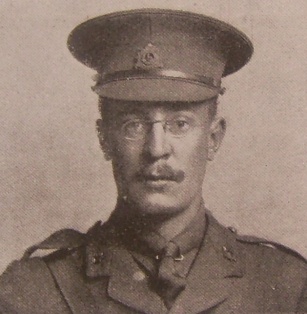
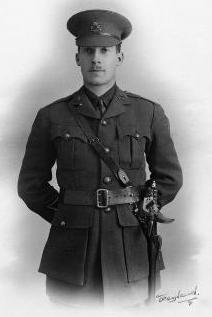
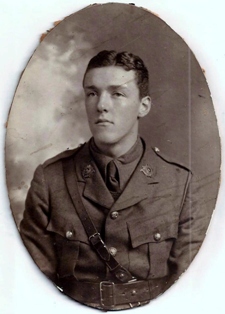
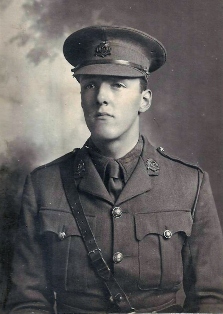 Edward
was born 28th December 1895 in Hong Kong, the eldest of six siblings,
to Edward William and Margaret Sarah Mitchell. His father worked
for Messr. Bradley & Co. of Hong Kong but Edward was educated at
Bedford Grammar School.
Edward
was born 28th December 1895 in Hong Kong, the eldest of six siblings,
to Edward William and Margaret Sarah Mitchell. His father worked
for Messr. Bradley & Co. of Hong Kong but Edward was educated at
Bedford Grammar School. 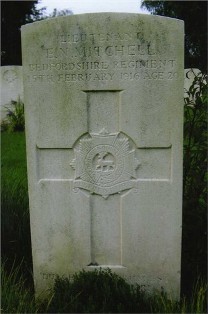
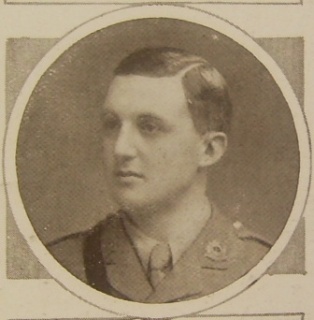
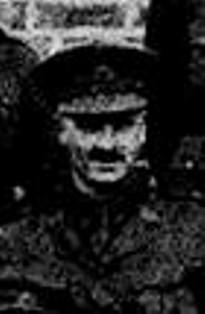 Charles
was born on the 25th November 1894 in Callington, Cornwall, the
son of the Reverend S.D. Cartwright, formerly the rector of Wimpole
in Cambridgeshire and Mrs W. Cartwright. Educated at Dunston College,
Cambridge, He was in their Cadet Corps during his schooling.
Charles
was born on the 25th November 1894 in Callington, Cornwall, the
son of the Reverend S.D. Cartwright, formerly the rector of Wimpole
in Cambridgeshire and Mrs W. Cartwright. Educated at Dunston College,
Cambridge, He was in their Cadet Corps during his schooling. 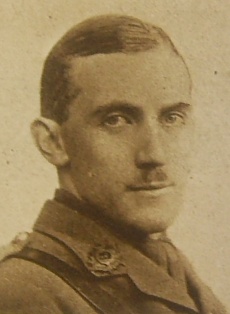
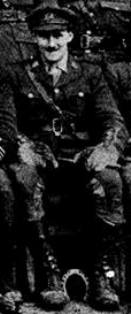 Roy
was born 29th October 1888 at Selsley House, Albert Road, Battersea
Park in London. He was the eighth of nine siblings of John S. Quilter
F.R.I.B.A. and Sarah Amelia Willis Quilter.
Roy
was born 29th October 1888 at Selsley House, Albert Road, Battersea
Park in London. He was the eighth of nine siblings of John S. Quilter
F.R.I.B.A. and Sarah Amelia Willis Quilter. 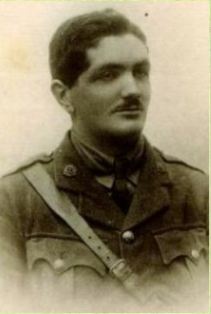
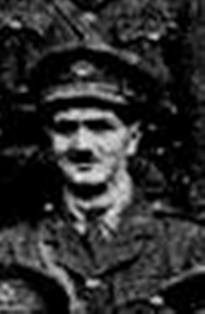 Douglas
was born in Oundle, Northamptonshire on 6th January 1893, the eldest
son of William McMichael. He was educated at Oundle School and later
at Clare College, Cambridge University.
Douglas
was born in Oundle, Northamptonshire on 6th January 1893, the eldest
son of William McMichael. He was educated at Oundle School and later
at Clare College, Cambridge University. 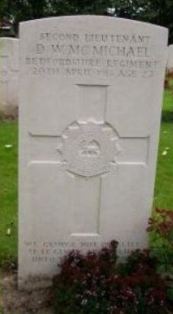
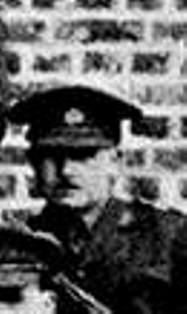 Harry
was born 16th December 1895 in New Cross, Deptford, the son of Harry
Squier.
Harry
was born 16th December 1895 in New Cross, Deptford, the son of Harry
Squier. 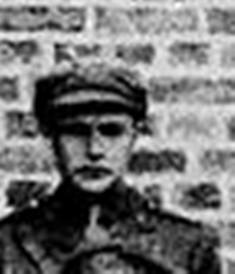 Edwin
was born 23rd September 1894 in Acton, the son of Edwin William
Draisey.
Edwin
was born 23rd September 1894 in Acton, the son of Edwin William
Draisey. 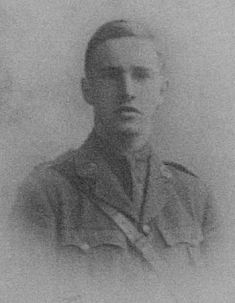 Colin
was born 21 August 1894 at Hampton Hill, Middlesex, the son of John
Kirkwood Leys and Ellen Leys. He was educated at The Royal Grammar
School, High Wycombe, for 2 ½ years, where he served in the O.T.C.
until discharged on the 19th December 1911.
Colin
was born 21 August 1894 at Hampton Hill, Middlesex, the son of John
Kirkwood Leys and Ellen Leys. He was educated at The Royal Grammar
School, High Wycombe, for 2 ½ years, where he served in the O.T.C.
until discharged on the 19th December 1911. 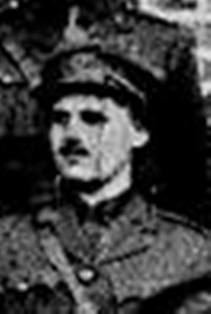 Honoratus
Thomas was born on 17th June 1895 in San Francisco, California,
the son of Commander George Charles, R.N.R. and Essie Thomas.
Honoratus
Thomas was born on 17th June 1895 in San Francisco, California,
the son of Commander George Charles, R.N.R. and Essie Thomas. 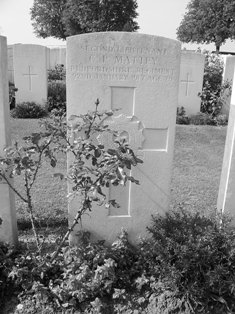 Charles
was born in 1887, the son of George and Elizabeth Mattey from Penglais
in Burghill, Hereford.
Charles
was born in 1887, the son of George and Elizabeth Mattey from Penglais
in Burghill, Hereford. 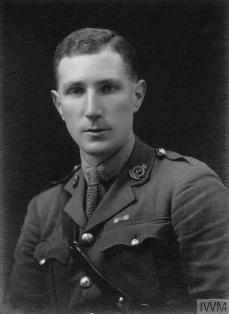 James
was the Royal Army Medical Corps (RAMC) Medical Officer attached
to the 8th battalion.
James
was the Royal Army Medical Corps (RAMC) Medical Officer attached
to the 8th battalion. 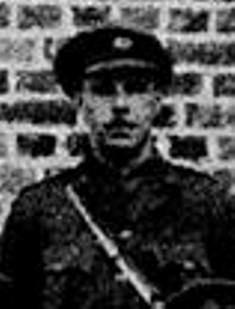 Rennie
was born 20th September 1893, in Transvaal in South Africa, the
son of George Rennie Airth and Alice Pemberton Airth (formerly White).
He spent 4 years in the Ley's College O.T.C., Cambridge between
September 1907 and July 1911, after which he went on to study as
a student in Mechanical Engineering at Camborne.
Rennie
was born 20th September 1893, in Transvaal in South Africa, the
son of George Rennie Airth and Alice Pemberton Airth (formerly White).
He spent 4 years in the Ley's College O.T.C., Cambridge between
September 1907 and July 1911, after which he went on to study as
a student in Mechanical Engineering at Camborne.